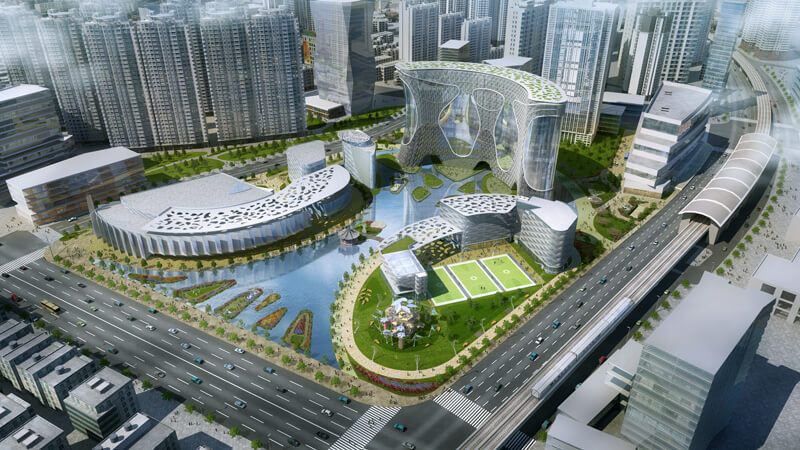Architectural Competitions in China: What You Have to Know in Order to Win

London-based firm winning entry–the Trade Centre in Zhengzhou, China. The Cradle Towers of Zhengzhou will comprise of five mixed-use towers swooping out of a ring-shaped podium. Inspired by the nearby Songshan mountainscape, the scheme aims to celebrate the city’s origins as it rockets into a high-tech future. Image courtesy of http://www.archdaily.com.
What You Need to Know
China loves competitions for architectural projects. In fact, they are mandated for all government projects and local developers use them to get ideas for the development. Winning architectural competitions in China is a task fraught with difficulty –but obviously not impossible -and there is a different way of going about winning these than anywhere else in the world. Understanding the process that is used in architectural competitions in China will greatly increase your ability to secure commissions and win competitions that actually bring you money.
Point # 1–Anonymity – No Such Thing in Architectural Competitions

One of the problems is that each submission is generally accompanied by a physical model. There may be no identifying marks on the model but the delivery person –or the local model makers know exactly who sent it and this information is generally cheerfully given on delivery. There is ‘certain’ anonymity with the judges of the competition. This means that the design is going to be judged on factors other than just impressing the judges. One of the real tricks in winning the competition is being able to assess the brief properly and work out which rules can be broken, and to do that means you need to have a working relationship with the organisers of the competition.
TIP: Let the lack of anonymity work for you –understand the Chinese way of doing things in the competition and work with it.
Point#2 -Back Room Deals -Getting Alongside the Stakeholders
The very complex thread of Chinese society demands that there will be many people who are owed favours or from whom favours are sought or where existing relationships override any other consideration. Winning the implementation part of that competition therefore required that the aspiring architect needs to have formed a relationship with a company that is not obviously visible. Someone needs to be on the ground doing research. Someone needs to find out all about the project, the people involved, who is not visible, and who is finally going to make the decision.
TIP: Whatever you read or believe about China please be aware that the Chinese government takes this issue very seriously and it would be wise to remember that in your dealings with Chinese offices.
Point#3 Relationships and Guanxi

Guanxi is a system of relationships developed over 5,000 years of Chinese history and it is the way in which business deals can be done with a degree of safety and certainty. By creating strong and mutually beneficial relationships with people in positions of power and authority the businessman creates an informal legal and insurance system. Before entering into a relationship with a Chinese businessman you need to have spent time developing your own Guanxi-relationships. Spending time with your Guanxi-partner is essential –you need to create a strong bond of friendship with him/her. Western companies rarely view this process as necessary and blunder into business deals without having the Guanxi-relationships in place beforehand.
TIP: A Guanxi-relationship starts with a genuine friendship.
Point#4 Design Institutes and How to Work with Them.
One of the most important factors in the competition is choosing the right Chinese partner to work with. China has huge local design institutes that do most of the design work (up to 10,000 people working in them including drafts people, designers, 3D artists, quantity surveyors, and workers from every possible combination of the design process). Certainly they are the ones generally used for the construction drawings, where so much of the work and money comes from and their rates are much lower than foreign architect firms. It is really important that the foreign architect is getting alongside these institutes at the beginning, finding out not only which institute the client prefers but finding out who in the design institute he is actually working with. Taking the time to get the right relationship with the design institute is worth its weight in gold.
TIP: When you approach the design institute that you want to work with don’t just roll up and expect that the person you are talking to is going to do everything and put your agenda at the top of his list.
Point #5 Don’t “Own” the Project, it’s Going to Change Before it is Built
It is unlikely that your design is going to see the light of day in the form it was designed. The final implementation then gets put through a design process by the client and the final result is probably not going to be what was envisioned by the architect. Rarely do foreign architects get it ‘absolutely right’ in the design –and that’s not a criticism of the foreign architect. Basically it can happen that maybe the number of units will increase dramatically from the brief. This happens because during the approvals process they manage to convince someone to increase the density, which means that the blocks are squashed together, green space reduced, towers get higher, and floor plans get squeezed. Developers take the ideas from a couple of the entries and start playing with the designs and come up with something completely different.
TIP: If you want to maintain your hair, your sanity and your China based business then learn these rules: Flow like water and don’t hit anybody (two driving rules in China).

Point#6- Payment Transfers
The general rule is that a local Chinese person who has moved to a western country approaches the architectural company with promises that they know how to win the competition for the company. For doing this there is a fee which is around 10,000 RMB for the ‘consultancy’ work and provision for a share in the implementation stage. The problem is the money –there is always a ‘cost compensation’ for the entry that rarely covers all the costs involved in the entry. The big red flag jumps up when the people running the competition have trouble with the transfers. There is often a lot of paperwork involved with this, and the agent offers to circumvent the bureaucracy by offering use of his bank account in China to get the money paid in RMB locally and the agent will offer to pay the money in foreign currency in the home country. One of the problems in this scenario is that the money required to chase this down is often more than the amount being paid. And while the agent was instantly available for all communications during the competition, when it comes to the payments, he is generally nowhere to be found.
TIP: Don’t use local agents for payment transfers

You need to realise that when you enter the competition everyone knows whose entry is whose–and yours will go to the top of the class if you have developed the right relationships. Moreover you need to be ready for second prize if you have formed the relationships –often second prize is a ‘gift’ project: a commission that is ‘given’ to you because they like you.



 Click to Visit Our Portfolio
Click to Visit Our PortfolioVR Property Sales Suite


 Click to Learn More
Click to Learn More




